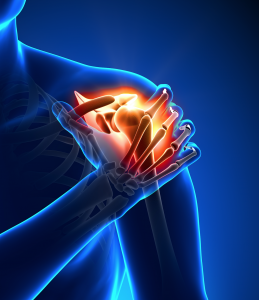PROXIMAL HUMERUS FRACTURES
This common condition is a fracture of the head of the humerus- the “ball” of the shoulder’s ball-and-socket. The majority of cases are non-operative and paired with immediate physical therapy tend to heal well with minimal to no loss of range of motion and the avoidance of frozen shoulder.
Causes of a Proximal humerus fracture
This type of fracture can be caused by direct trauma to the shoulder. It commonly affects elderly people whose bones have been weakened by osteoporosis. Since osteoporosis is the main risk factor paired with a fall onto a outstretched arm women have a rate of incidence 2:1 to men with this type of fracture, and this fracture represents about 1/20 of all fractures seen by providers. Diabetes and epilepsy are also correlated with proximal humerus fractures due to the increased risk of falling associated with those conditions.
Symptoms of a proximal humerus fracture
 This fracture can be very painful and may make it hard to move your arm. The arm can be severely swollen at the shoulder, the arm may not be able to be moved, and the pain can be quite severe.
This fracture can be very painful and may make it hard to move your arm. The arm can be severely swollen at the shoulder, the arm may not be able to be moved, and the pain can be quite severe.
Treatment of a proximal humerus fracture
Treatment options depend on the severity of the fracture. If the bones have not shifted, the fracture may be treated with a sling. If the bones have become displaced, surgery is needed to realign and anchor the bones or to replace the joint. The majority of proximal humerus fractures are non-displaced and treated with a sling. The most common associated damage sustained from the fracture of the proximal humerus is damage to the axillary nerve. Vascular damage is rare. Damage can occur to the rotator cuff.
Recovery from a proximal humerus fracture
If there is minimal displacement a sling for comfort can be worn for 2-3 weeks paired with immediate physical therapy so that range of motion can be retained. In cases with displacement a closed reduction with pinning, ORIF, Intramedullary nailing, hemiarthroplasty, total shoulder arthroplasy, and reverse shoulder arthroplasty may be considered as potential options for the surgeon’s consideration depending on the nature of the fracture. Surgical intervention may need to be paired with physical therapy to maximize range of motion of the shoulder joint and restore strength to the arm and shoulder.

